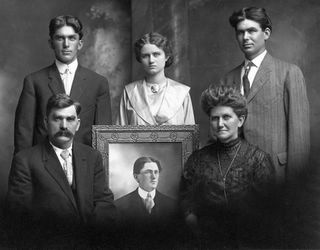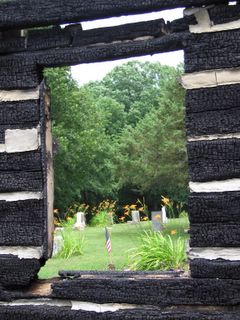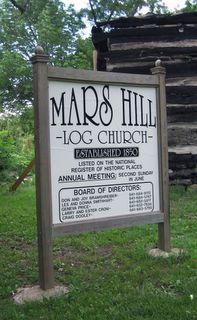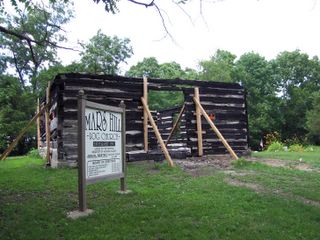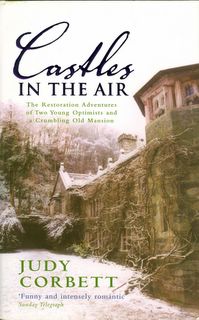
Communicants and friends entering the main door of Chariton’s St. Andrew’s Episcopal Church during its second incarnation, roughly from late 1904 until the building’s demise during the mid-1950s, would have passed a large and finely crafted (by the Gorham Manufacturing Co. of New York) bronze tablet upon which words cast in raised letters read : “To the Glory of God and in Grateful Recognition of the Liberality of Elizabeth Evans F. Hammer, Born December 7, 1815, died January 30, 1896, Whose Generous Bequest to St. Andrews Parish Aided Greatly the Erection of this Church.”
Elizabeth’s memorial tablet was the lesser of two Gorham creations in the church. A larger tablet erected to the glory of God and in memory of Smith H. Mallory, whose $10,000 bequest during 1903 allowed completion of a building begun with Elizabeth’s 1896 bequest of roughly the same amount, was displayed more prominently --- on the north wall of the choir to the immediate left of the altar.
The precedence given Mallory is not surprising. He had been, after all, a member (although not yet confirmed an Episcopalian) from organization of the parish on 13 June 1866 until his death on 26 March 1903, was an alpha male and arguably Lucas County’s (if not southern Iowa’s) most prominent citizen of that era. He also had the foresight to leave behind a widow, Annie, and daughter, Jessie, to ensure for at least a few last golden years that his proper place in the precedence of things was recognized.
Elizabeth, although no less devout and substantially more generous if percentages of the respective Hammer and Mallory estates designated for good works are considered, was operating with two disadvantages: She was a woman and she left no descendants.
In the end, the legacies of both turned to dust in worldly terms. St. Andrew’s the second was demolished and both memorial tablets went missing in the confusion of that congregational and architectural disaster.
But time delivered to Elizabeth a degree of recompense. Her polished granite tombstone topped by a marble urn stands tall in the Russell Cemetery, and her mortal remains rest there still, secured by a slate vault purchased from Dr. J.E. Stanton of Chariton for $60 (then a remarkable amount) upon her death.
Mallory, by contrast, was unceremoniously uprooted from the Chariton Cemetery by his daughter during the 1920s, his body cremated and both his ashes and the spectacular Celtic cross that had marked his grave shipped off to eternal obscurity in a Florida cemetery.
In the beginning:Elizabeth was born, her obituary (Chariton Democrat, 7 February 1896) tells us, on 7 December 1815 in New York to William and Dorothy Evans, one of nine children --- all but one of whom predeceased her --- and was married to William Fulkerson about 1833. I do not know where that marriage occurred or the circumstances --- other than the fact that they were childless --- of their early years together.
Prior to October of 1850, William and Elizabeth had moved to Waukegan, Illinois, located north of Chicago in Lake County --- so called because Lake Michigan formed its eastern boundary. William and Elizabeth, along with Mary Mason, age 13, born in Michigan, were enumerated as a separate household within the home there of William J. and Sarah Dennis and their children, Mary A., 3, and Joseph, 1. The occupation of both William Dennis and William Fulkerson was given as farmer, although Dennis was credited with real estate valued at $1,200 and Fulkerson apparently owned none.
About 1854, the Fulkersons moved west to Washington Township, Lucas County, settling on a 240-acre prairie farm two miles south and a mile east of what would become Russell --- a farm later owned and occupied by three generations of the Kells family for more than a century. Here, the Fulkersons prospered.
Elizabeth, according to her obituary, “at a very early period in life … was confirmed in the Episcopal Church of which she ever remained a devout communicant.” William may or may not have been an Episcopalian. There are no records to tell us.
Elizabeth, we know, was involved in forming an Episcopal parish at Russell immediately after the town was organized along the Chicago Burlington & Quincy (then the Burlington and Missouri River Railroad) rail line during 1867.
Susan Day, in her 1914 “A Brief History of Russell, Iowa,” tells us that “The first church, the Episcopal church, which was established in 1868, did not prosper, owing to its weakness in membership, and was soon disbanded and the church building was sold for other purposes, and it is now (during 1914) occupied by I. E. Raines as a paint shop.”
Charles M. Wright, in his 1967 “Russell Centennial Book,” adds a few details: “As soon as the rails arrived in the town (during 1867), the railroad authorized the newly appointed agent, N.B. Douglas, to offer two lots and a cash subscription to the first denomination that would build a church in the town. By August, the Episcopalians accepted this offer. Eventually they were given three lots and a fourth was sold to them for $25. A subscription of $50 was then granted to them for their new edifice.
“Even before this transaction was completed,” Wright contines, “the Presbyterians, hearing of the matter, offered to put a building under way immediately in exchange for two lots and a cash donation. Douglas wrote for instructions. ‘I think,’ he observed, ‘that two churches would be a great benefit to the growth of the town.’ Asked for more details by the authorities, Douglas reaffirmed his belief that ‘two churches would flourish here.’ The Episcopalians, he explained, had then only a few members, but the were ‘all of a wealthy aristocratic class.’ They already had six loads of timber on the spot and planned a structure 30 by 60 feet, with a tower and steeple in front. The Presbyterians, with a large and active membership, expected other denominations to help build their church in return for using it a portion of the time. Thereupon the second donation was authorized.”
“It was Dr. LaBach of Chariton,” according to Wright, “who came to Russell and began the preparation for the building of the Episcopal house of worship. This was completed in the spring of 1868, but owing to weakness in membership the church did not prosper and was soon disbanded. The building was then sold for other purposes.”
Praise, too, for the Rev. Isaac Peter LabaghWright is mistaken in attributing to Dr. “LaBach” first work among the Russell Episcopalians. The gentleman in question actually was the Rev. Isaac Peter Labagh, a pioneering Episcopal missionary whose name certainly should be spelled correctly and whose work in Lucas and Monroe counties deserves proper acknowledgement.
The Rev. Mr. Labagh, whose work in the Diocese of Iowa from 1865 until his death during1869 was sponsored by the Board of Missions of the Protestant Episcopal Church, arrived in the state during July of 1865 when shortly before his 61st birthday he was named rector of St. Peter’s Church in Fairfield.
As the tracks of the Burlington and Missouri River Railroad (later Chicago Burlington & Quincy) pushed west after the close of the Civil War, Labagh and his family followed.
He was appointed 5 August 1867 as the first rector of the newly-organized St. Andrew’s Church, Chariton, and also was named at about the same time to serve as rector of Grace Church in Albia. He moved with his family to Russell, a new town platted during October of 1867 along the B.&M.R.R. route in Washington Township, Lucas County, between Albia and Chariton but now accessible to both by rail, and set about planting a third Episcopal church, St. Mark’s, there.
Labagh, born 14 August 1804 in Leeds, Green County, N.Y., was a fascinating character who embodied the missionary zeal of the Episcopal church of that era. His father, the Rev. Dr. Peter Labagh, was a prominent minister of the Dutch Reformed denomination. Isaac was determined to follow in his father’s footsteps, and in preparation for that calling graduated from Dickinson College, Carlisle, Pa., during 1823 and the New Brunswick Theological Seminary of the Dutch Reformed Church, then sharing facilities with Queen’s College (now Rutgers University), New Brunswick, N.J., during 1826. He then served Reformed congregations in Rochester, N.Y., and Gravesend, Long Island.
During 1842, however, he was suspended by the Reformed general synod “for views expounded concerning the second advent and the Christian Sabbath.” He found a welcome, however, within the Protestant Episcopal Church during 1846 and never looked back.
His first work as an Episcopal missionary was among the Jewish population of New York City. He then founded and built Grace Episcopal Church, Gloucester, N.J., and St. Paul’s Church, Brooklyn, N.Y., and “resuscitated” Calvary Church of Brooklyn, “which had fallen into decay.”
During 1860, he moved west to McHenry County, Ill., where he established a seminary for girls called Euphemia Hall in Maringo, which burned during 1862.
Throughout his career, probably to the occasional dismay of his family, the Rev. Mr. Labagh financed mission efforts with his own funds. That was the case with Euphemia Hall, in which he had invested an estimated $15,000, all lost when it burned.
Undeterred, Labagh moved to Cairo, Ill., where he built St. Peter’s Episcopal Church before commencing work in the Diocese of Iowa.
St. Mark's Episcopal Church:As Charles Wright recounted in his Russell history, the Rev. Mr. Labagh was the first in Russell to take up the railroad offer of lots and a financial subscription in return for the promise to build a church. On 23 April 1868, Henry S. Russell, trustee, deeded lots set aside for the Episcopalians the previous fall, Nos. 143, 144 and 145 in the original town of Russell, to Isaac P. Labagh, trustee of the Russell Episcopal congregation.
Labagh had purchased a fourth lot, No. 142, from Henry Russell for $25 during March of 1868. Interestingly, the purchaser of record for this lot was listed as the Rev. Mr. Labagh’s son, Reginald Heber Lebagh, then 19. And it’s interesting to speculate about why. The most likely explanation is that the Rev. Mr. Labagh’s habit of financing mission work out of his own pocket left his family financially vulnerable and that this was intended to offer some degree of security. Accounts of Grace Church in Albia, for example, state that its building was financed in large part with funds advanced by the Rev. Mr. Labagh. Those accounts go on to state that Grace ran into financial difficulty during the 1870s and actually lost the building to creditors other than Labagh, who sold it to the Roman Catholics of that city.
Whatever the case, St. Mark’s Episcopal Church was constructed in Russell during 1867-68. Lots 142-145 formed the south half of the city block in the northeast corner of the intersection of Prairie and Ames streets. It seems likely that the church was constructed to the east and the Labagh home, on Lot 142 at the southwest corner, a site now occupied by a service station, but there’s no way to confirm that.
St. Mark’s had been enclosed by February, 1868, and a festival was scheduled to raise funds for outfitting it, as reported in The Chariton Democrat of 22 and 29 February:
“FESTIVAL AT RUSSELL: All of our people ought to go to the festival to be given in St. Marks (Episcopal) church, at Russell, on next Tuesday evening. A special train will leave Chariton between six and seven o’clock, and carry passengers free. A grand time may be anticipated, and a pleasant little ride “into the bargain all free gratis for nothing,” Superintendent Perkins having generously placed a train at the disposal of the society. Supper tickets 50 cents.” (22 February)
“THE RESTIVAL AT RUSSELL: The festival held in the Episcopal church at Russell, on Tuesday evening, was one of the pleasantest affairs of the season. The church has just been enclosed, and the object of the festival was to raise funds to fit it up. A large number of Chariton people went down by the special train, and those in the vicinity of Russell turned out almost en masse. It was expected that Albia would send up a delegation also, but by reason of some misunderstanding they did not come. Mrs. Fulkerson, one of the founders of the church, desires to thank the people of Chariton for the generous manner in which they resonded to the institution, and assures them that when an opportunity occurs to reciprocate, Russell will turn out in full. The net receipts of the festival amounted to $41.” (29 February)
Sadly, the Rev. Mr. Labagh became ill during the closing months of 1869 and on 29th December of that year died in in Fairfield, probably at the home of his son, Peter.
Although both St. Andrew’s and Grace continued, St. Mark’s did not survive the Rev. Mr. Labagh for long --- and its interesting to speculate about what its outcome might have been if that dynamic individual had lived longer. The deed transferring three lots to Isaac Labagh specified that they be used only for church purposes, so once the Russell church closed its doors the lots defaulted to the Russell trustees. They were sold on 21 June 1873 to D. F. Comstock, a Russell businessman. This suggests that the Russell congregation probably survived for four years at the most.
Reginald H. Labagh retained ownership of Lot No. 142 until 3 June 1879 when he (then a resident of Chicago) sold it to Rowena (Sargent) Haywood for $100.
Elizabeth soldiers on:While there is no record to tell us exactly when the Episcopal church in Russell closed its doors, Elizabeth Fulkerson seem to have been undeterred and apparently not tempted to join another denomination. Instead, she shifted her allegiance to St. Andrew’s of Chariton.
Elizabeth and William were enumerated in the 1880 census as residents of the village of Russell, so apparently lived there rather than on their Washington Township farm until his death on Friday, 31 Decemeber 1880, at the age of 69 years, 10 months and 17 days. The Fulkersons had purchased lots in Russell as soon as it was platted and also owned lots in Chariton, where they reportedly also lived for a time.
William Fulkerson’s passing drew brief note in The Chariton Patriot of Wednesday, 5 January 1881: “Wm. Fulkerson, whose death was briefly noticed in Friday’s Daily, was an old citizen of the county, having located on the farm near Russell where he died, over 26 years ago. He was 70 years of age, and had been sick about a week of congestion of the lungs. He leaves an estimable wife to mourn his departure. The funeral will take place tomorrow at Russell under the Masonic auspices.” William was buried in the Russell Cemetery.
An astute businesswoman, Elizabeth managed a substantial amount of property in the Russell area and enjoyed income both from rent and from cash loaned at interest to various people and institutions in the community. She also built a substantial brick home --- a rarity in Russell --- probably the house in the east part of town that later served as a private home, then as the O’Donnell Nursing Home and eventually was demolished.
About seven years after the death of William Fulkerson, Elizabeth married Eli F. Hammer on 4 September 1888 at the Methodist Episcopal Church in Russell (of which Hammer was a member) with the Rev. Francis Duncan Jaudon, rector of St. Andrew’s 1888-1891, officiating.
Eli, born 1 January 1826 at Greencastle, Ind., had married Mrs. Demitha Branham, some 10 years his senior, 1 September 1848. The Hammers were prosperous but childless farmers who lived in Wright Township, Wayne County, just a few miles south of Russell probably in or near what was known as the Dry Flat neighborhood. Eli and Demitha were charter members of the Russell Methodist congregation.
Demitha Branham Hammer died 25 March 1887, a year and a half before Eli’s marriage to Elizabeth, and she, too, was buried in the Russell Cemetery.
Eli and Elizabeth moved into Elizabeth’s home in Russell and apparently lived there contentedly until the late fall of 1895, when old age and circumstance conspired against them. A Chariton Democrat news item of 31 January 1896 states that Elizabeth had sustained injuries a few weeks earlier in a fall, then became ill with “lagrippe.” Eli, according to The Democrat, became ill at about the same time. She died in their Russell home at 1 a.m. on Thursday, 30 January, age 80; and Eli died a few minutes later, at 1:35 a.m., age 70.
Joint funeral services were held at the Fulkerson/Hammer home Friday afternoon, 31 January, conducted by the Rev. A. W. Armstrong of the Russell M.E. Church, and by the Rev. William V. Whitten and the Rev. J. A. Russell, of St. Andrew’s. Elizabeth then was buried in the Russell Cemetery beside her first husband and Eli, beside his first wife, Demitha.
The benevolence of Elizabeth E.E.F. HammerElizabeth and Eli had not mixed their assets upon marrying and owned no property jointly. In her will, she left $4,400 to be divided among five people: Amelia Miller, $200; Doratha McKinley,$1,800; H. Everett, $2,000; Mary E. Carpenter, $200; and Minnie Miller, $200. She also provided for Eli Hammer’s brother, Isaac, of Wisconsin, by ordering that he be paid $5 monthly from her estate so long as he lived.
The balance of Elizabeth’s assets was willed to churches. St. Andrew’s Episcopal was the principal beneficiary, receiving $500 outright and the residue of her estate once other bequests had been paid and accounts settled. The other congregations that she remembered, each of which received $200, were the Russell M.E. Church, Russell Baptist Church, Russell Presbyterian Church, Trinity Evangelical Church (located a mile east of the Fulkerson farm and now known as Center Community Church) and Dry Flat Evangelical Church (also known as Goodwater Church), located in the Wayne County neighborhood where Eli had lived before his marriage to Elizabeth.
Elizabeth named George W. Plotts, variously a Russell farmer, meat market operator and grain dealer, to administer her estate. At the time of her death, he was leasing her brick business building on Russell’s main street and seems to have functioned as her manager.
It took two years to settle Elizabeth’s estate. Her biggest asset, the old Fulkerson farm of 240 acres, was sold to Charles A. Kells for $8,400 during 1898. That farm, which remained in the Kells family until 2006 when it was sold for only the second time in its history, was valued in 21st century dollars at many times that amount.
On the 25th of April, 1898, Lucas County’s probate judge approved payment of specific bequests, including $500 to St. Andrew’s. By October of that year, St. Andrew’s also had received $6,300 from cash in hand after all other bequests and bills had been paid, and at St. Andrew’s request, remaining assets of the estate had been transferred to that congregation, as well as the obligation to pay Isaac Hammer $5 per month until his death. Those assets included title to Elizabeth’s brick business building and brick home as well as a vacant lot in Russell. A variety of household goods and uncollected notes, including one for $320 against the trustees of Russell First Baptist Church, also passed to St. Andrew’s as did several hundred dollars in cash.
When all was said an done, St. Andrew’s received approximately $10,000 from the Fulkerson/Hammer bequest, an amount sufficient to allow the congregation to begin planning a grand new building to replace the modest frame structure that had served it since 1868.


















